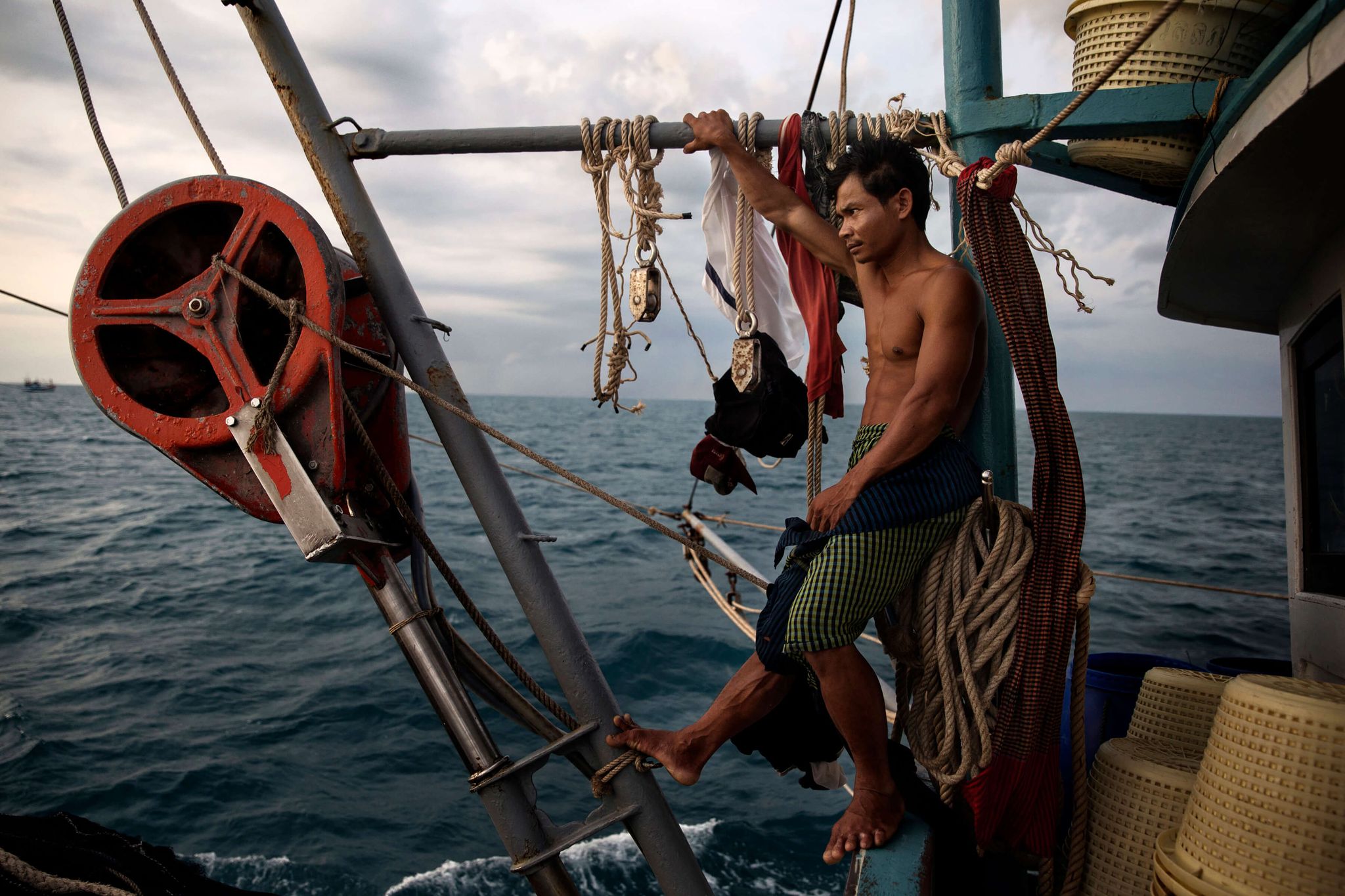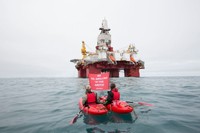What can we do to mitigate the mayhem offshore? Given the scope of the problems, this is a difficult question. Tackling the topic can seem as overwhelming as solving climate change. We all recognize that our individual actions will not, on their own, stop the planet from overheating. Still, many people want to know how they can make a difference. They want to feel like they are a part of the solution, not part of the problem.
Albeit small, there are clear benefits to, say, making sure your tires are properly inflated to improve gas mileage or buying carbon offsets to lessen the impact of emissions from an airline flight. But the little and personalized steps that average people might take to guard against the illegal, dangerous, and inhumane acts at sea are tougher to pinpoint.
And yet, there are ways to make a difference. Among them is to support, financially or otherwise, the organizations that are on the frontlines and tackling some of the stubborn realities portrayed in these pages. Vet them for yourselves, but here is a brief tour of some of the organizations doing this work. I also offer broader context on steps that governments and companies are taking—or should be taking, according to advocates and researchers—to better police the high seas.
Protecting Mariners
Mission to Seafarers and Stella Maris are two highly effective groups that directly help crew members who have been abandoned, not paid, physically harmed, or trafficked. Historically, the largest of international transport unions, ITF, has focused primarily on protecting crews on freighters, tankers, and cargo ships, but in recent years the union has broadened its mission to also guard against abuse of workers on fishing boats as well.
One of the greatest risks of forced labor and human trafficking is that many fishermen are migrant laborers, who are highly vulnerable to exploitation. Protections for and attitudes toward migrants are very important in trying to mitigate their exploitation. Several groups, including the Environmental Justice Foundation, Human Rights Watch, Greenpeace, and the International Labor Rights Forum, publish invaluable investigative reports about labor abuses on fishing ships, especially in South Asia and the Far East. These groups, along with the International Labor Organization, play an important role behind the scenes, pushing for stronger laws and better enforcement to protect workers on these boats. Sea Shepherd, on the other hand, relies less on research to apply policy pressure on governments or companies. It uses direct confrontations with its adversaries to produce publicity and raise awareness.
Forced labor is more common on fishing ships that stay at sea longer. These ships avoid docking and spot checks by onshore inspectors sometimes for years by relying on transshipment, with supplies carried to the fishing boats and the catch transported back to shore. Transshipment enables unscrupulous fishing boat operators to keep crews captive and to lie about their catch on documents they give to customs authorities, making it seem as if it were caught legally when it was not.
That is why many labor and environmental advocates argue that governments and fish buyers should require fishing ships to make more frequent visits to shore. They also contend that transshipment at sea should be banned or limited.
In 2017, the UN’s International Labor Organization took steps to prevent the stranding of hundreds of seafarers each year on abandoned ships at sea or in port. Shipowners were required to show proof of funds to cover four months of crews’ wages and the costs to repatriate them. Operators also have to prove they can cover costs that result from death or long-term disability of seafarers due to occupational injury. Labor advocates say this sort of insurance is essential but the requirement should be expanded to fishing boats, which are currently exempt from this mandate and most of the labor organization’s other major protections.
Anti-trafficking groups have encouraged seafood and shipping companies to minimize their exposure to labor abuses by avoiding or at least carefully vetting any manning agencies used to recruit and manage crew members. Companies can also insist that they be provided copies of the contracts signed by workers, while prohibiting the use of up-front recruitment fees that are often used to trap workers in debt.
The most diligent companies can hire consultants to conduct spot checks as well as exit interviews of a subset of former workers to check for common problems like hidden deductions withdrawn from workers’ paychecks, promised wages that were never paid after workers returned home, or blacklisting of workers who speak up about environmental or labor violations.
A More Transparent Food Supply
Current fishing practices are unsustainable, and many marine scientists have called for creating more marine protected areas that are mostly or entirely off-limits to large-scale commercial fishing and other industrial activities. Researchers also argue for scaling back the size of the global fishing fleet, tightening the quotas that limit how many fish can be pulled from the water, and removing the government subsidies that make seafood artificially cheap. All of these goals require aggressive enforcement and commitment from governments to prosecute illegal fishing companies.
In recent years and with mixed results, various industries have reckoned with labor and environmental abuses within their supply chain. Consider, for instance, conflict-free diamonds, dolphin-free tuna, fair-trade coffee, and sweatshop-free garments. The targeting of over-exploited stocks include a proven, vicious cycle between environmental degradation and labor abuses. There is a proven, vicious cycle between environmental degradation and labor abuses. Research by Jess Sparks describes it well. The global seafood industry is slowly beginning to confront these problems.
Technology exists to better track fish as it travels from bait to plate, and an emergent movement is pushing to make seafood more traceable. Governments and large seafood sellers are considering mandating the use of DNA field kits for identifying species to combat the problem of counterfeit fish. They are also considering tracking packages more aggressively with bar-coded labeling, and employing algorithms to flag high-risk imports like those coming from vessels that have past violations and those carrying shipments routed through border crossings commonly associated with organized crime.
Grocers and restauranteurs are turning to nonprofit groups like FishWise or for-profit firms like SCS Global and Trace Register for consulting services and supply-chain audits. Greenpeace’s “Carting Away the Oceans” report card ranks supermarkets based on ethical purchasing decisions, supply-chain transparency, and fishery-to-shelf traceability. In 2018, more than 90 percent of retailers received passing grades, but only four—Whole Foods, Hy-Vee, Aldi, and Target — received “green” sustainability scores. Most, like Walmart, Costco, and Kroger, fell somewhere in the middle of the scale.
Seafood companies are also considering requiring any vessels that catch or carry their fish to have a unique vessel identifier or International Maritime Organization (IMO) number, which remains constant throughout the vessel’s lifetime, regardless of change of name, ownership, or flag. If a ship lacks this type of identifier, companies that get goods or fish from it have no way of knowing where it traveled, whether its workers had contracts, and whether it is on any of the black lists maintained by regional fishery management organizations. In 2017, the UN’s Food and Agriculture Organization has taken a step toward consolidating this information by publishing an online, global, one-stop database of vessels.
Advocates have called for fish buyers to source only from countries that have ratified international agreements such as the Port State Measures Agreement, a UN treaty that outlines rules for how ships visiting a nation’s port should be inspected. Another important requirement is for fishing ships to carry observers, who are answerable only to local fishery authorities. The job of these onboard observers is to monitor and document a vessel’s compliance with quotas and check for other possible crimes like shark finning, excessive bycatch, or high-grading (the practice of throwing older fish overboard to replace it with newer catch). These observers should also be responsible and empowered to report on labor conditions and violations.
Consumers are also paying more attention to these issues, and a growing number of them are opting to avoid seafood (and meat) altogether. For people who eat fish but hope to distance themselves from possible environmental or labor abuses, there are ways to be better informed about the companies supplying the fish.
Among the smartest writers on this topic is Paul Greenberg, who notes that the most problematic fish are shrimp, tuna, and salmon because they are overwhelmingly imported and they involve especially long and opaque supply chains that may include companies that engage in environmentally illegal or unsustainable practices. “Eat American seafood and a much broader variety than we currently do,” Greenberg suggests. Mollusks like clams, mussels, and oysters are often ecologically beneficial to grow and can be produced with much lower impact to the environment. Other American seafood that he says is worth putting on your plate are Alaskan sockeye salmon, which are very well managed and high in omega-3s.
Greenberg further advises consumers to steer clear of seafood and omega-3 dietary supplements that are connected to the “reduction industry”—a massive industrial sector that boils down twenty-five million tons of wild fish a year into fish oil for dietary supplements and fish meal that gets fed for protein to chicken, pigs, and farmed fish. These pills remain popular despite a growing body of medical research undercutting the idea that the supplements provide any real health benefits. A better option to fish-based omega-3 supplements are ones made from algae.
For further guidance, consumers can consult the Monterey Bay Aquarium, which produces seafood report cards that rank fish from an environmental perspective as “red” (avoid), “yellow” (good alternative), and “green” (best choice). Over fifty-five million of the cards have been downloaded or otherwise distributed by the aquarium, which recommends, for instance, that if a consumer wants to buy crayfish, choose that which is farmed in the United States. The cards warn against buying bluefin tuna, but tilapia, which is almost exclusively farmed, is generally a good option. Much depends on where the fish was caught or farmed and what methods were used to harvest it. Atlantic salmon farmed in marine net pens in Norway’s Skjerstad Fjord is considered a “best choice,” for instance, while the same species farmed in Canada’s Atlantic should be avoided.
The Monterey Bay Aquarium Seafood Watch program has partnered with the Sustainable Fisheries Partnership and Liberty Shared to create the Seafood Slavery Risk Tool. This Risk Tool aims to help seafood businesses identify the risks of forced labor, human trafficking, and hazardous child labor in their value chains. Organizations should use the Risk Tool’s outputs as a starting point to effect change where most urgently needed.
Patagonia toothfish, for example, is considered “low risk” if it is caught in Argentina, Chile, or Australia but “high risk” if it comes from South Korea. Searching “tuna” reveals a dismal state of affairs in the South Pacific: almost all tuna from Taiwan, except tuna certified by the Marine Stewardship Council, is considered “critical risk.” The tool is produced primarily for businesses in the seafood and financial industries, but the aquarium encourages nonprofit groups, consumers, and anyone else with an interest in ethical seafood to use it. WWF also publishes a useful country-by-country guide on sustainable seafood.
Monitoring And Investigating Offshore Crimes
There’s a surprising lack of publicly available information about violence at sea. To avoid the abuse or disappearance of seafarers, governments will likely have to increase their spot checks on ships returning to port and levy heavier penalties for incomplete or falsified crew lists. Human rights researchers also suggest that shipowners and crews should be legally obligated to report crimes at sea. The resulting data should not be held privately by insurance companies or flag registries but be made available to the public. Maritime investigators and insurers have called for the creation of a public database for tracking missing mariners. Flag programs should also be required to contribute to it.
For a useful framework on how to increase the amount of usable information about crime at sea, labor advocates point to two existing measures: the federal Cruise Vessel Security and Safety Act, which mandates reporting of criminal activity on passenger ships to the FBI, and the Declaration Condemning Acts of Violence Against Seafarers (the Washington Declaration), in which major flag states commit to reporting to the International Maritime Bureau when seafarers face violence at sea. These measures could be expanded to apply globally but would need to be obligatory and come with heavy fines and potential prison time for those who fail to comply.
Union officials and labor rights researchers also say that countries should sign the Maritime Labour Convention, which is a global set of standards for protecting workers’ rights at sea that applies to all ships entering the harbors of parties to the treaty as well as to all states flying the flag of state party. By ratifying this measure, governments could enforce higher standards of paid leave, wages, medical care, and safety rules on foreign-flagged vessels as part of Coast Guard inspections during visits to their ports. As of 2018, over eighty-five countries, not including the United States, had ratified the measure. Labor advocates also call for countries to ratify the International Labor Organization Convention 188, which aims specifically to improve conditions on fishing boats. The vastness of the oceans makes it easy for poachers to thwart government quotas, enter forbidden areas, and pillage sanctuaries. As a result, pirate fishing boats are responsible for over 20 percent of the wild-caught seafood imported into the United States, and the percentage is likely higher abroad. Requiring all fishing ships to have VMS and AIS tracking devices would help allow the public and law enforcement to track activity at sea.
Flags of convenience often provide cover for scofflaw fleets. Many registries fail to exert oversight of member ships. More responsible companies will require that the ships that are part of their supply chain only fly the flags with strictest accountability and transparency standards. The ITF and Seafarers International Research Centre provide ranking of flag registries based on labor standards.
Several organizations focus on improving offshore monitoring. Global Fishing Watch, for example, tracks fishing ships and makes the information public. Trygg Mat Tracking, FISH-i Africa, C4ADS, and Windward investigate ships suspected of engaging in criminal behavior. Human Rights at Sea produces reports on abuses of seafarers. Earthworks tracks mining companies that dispose of hazardous wastein the ocean. The Pew Charitable Trusts produces a steady stream of invaluable research on the global problem of illegal fishing.
In terms of clarifying and strengthening the rules about what types of commercial activities can occur in international waters, the High Seas Alliance, a coalition of more than thirty-seven organizations, has been an important driving force. In particular, the alliance has spear-headed the negotiations around a UN marine biodiversity treaty that will create a formal process for setting aside protected marine areas in international waters. Unlike on land, there is no legal framework on the high seas for creating areas that are off-limits to commercial activity. The treaty will also create procedures for environmental impact assessments and establish a method for the public to be informed about large-scale projects in these waters, including fishing, seabed mining, shipping, research, and other activities.


